Roman Blind Guide
Roman Blinds – A Complete Guide
What is a Roman Blind?
A Roman Blind is simply a panel of fabric made to fit a window with a system of rods and cords allowing the blind to be raised during the day and lowered at night. It is a stylish and cost-effective solution allowing your window to be beautifully finished with a fabric of your choice to match your décor. There are literally thousands of fabrics to choose from (don’t worry we can help you with that) meaning you can create a uniquely individual scheme.
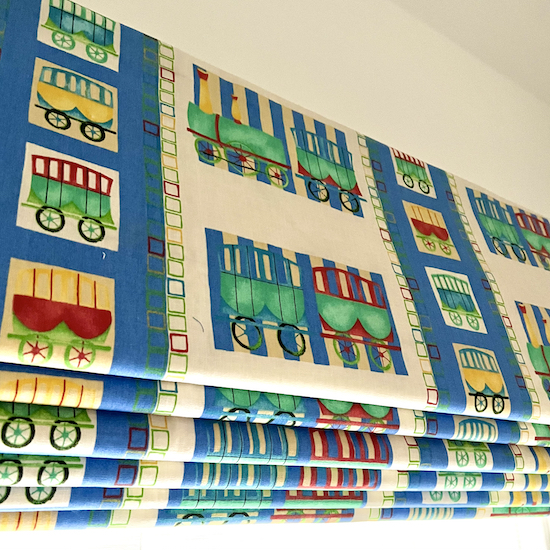
Roman Blinds or Curtains?
We spend a lot of time standing in front of windows with clients discussing whether the best choice is a Roman Blind or Curtains, or perhaps even both. There are a number of factors to consider and it’s well worth taking the time to come to the best decision. Often the first consideration unfortunately is whether there is a radiator below the window. Floor length Curtains always finish a room beautifully, but if there is a radiator below the window it’s not a great idea to cover it with Curtains when the heating is on. Curtains falling to just below the sill avoids the radiator issue, but they never look quite as stylish as floor length. A Roman Blind is often the best solution in this situation, shutting out the dark with a lovely fabric and leaving the radiator to heat the room.
There is though another possibility here – subject of course to budget – and that is to have both floor length Curtains and a Roman Blind. This is often the perfect solution. The Roman Blind can be used in the winter when the heating is needed, then in the summer either the Blind or Curtains can be used. There is also a further option here and that is to make the Curtains as ‘dress’ Curtains. This means they are made just to cover two thirds of the window, so they don’t close fully. This means there is a fabric saving on the cost of the Curtains and the Roman Blind is used all year round. Two thirds width for the curtains is ideal, any less and the curtain stacks will look obviously too narrow for the window.
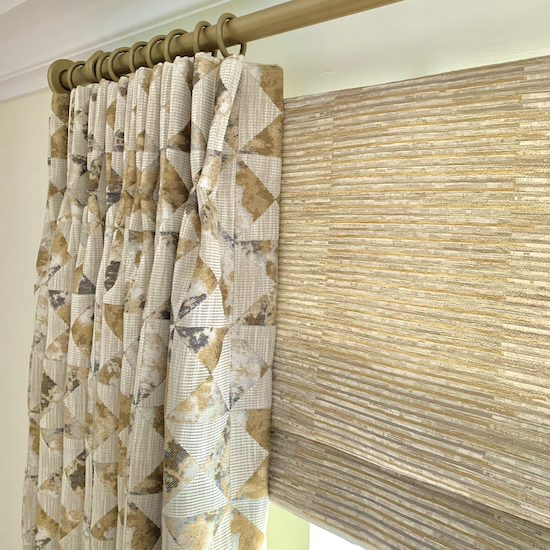
If there is no radiator, then the next two considerations are usually the style of the window and budget.
Roman Blinds are budget friendly as they have the advantage of using much less fabric than Curtains, plus there is no need for a curtain pole or track as the Blind is fitted to a modern rotary chain headrail. The other key difference with a Roman Blind compared to curtains is the finished effect of the fabric. A Roman Blind is a flat panel of material which is raised in folds to open the blind. This means that when the blind is down, if the fabric has a pattern, then the design is shown in full. Whereas for curtains, even when the curtains are closed, there is still fullness with the pleats in waves to the front and the back. That is a lovely effect in itself, but it does mean the pattern shows itself in a different way to a flat panel. Some fabric designs therefore can work better for Roman Blinds than they do for Curtains, but also vice versa. This is well worth bearing in mind when choosing fabrics.
In terms of the style of the window, some windows lend themselves more to Curtains and some to Roman Blinds so the choice is straightforward. For example, full length windows and patio doors are perfect with Curtains, whereas for kitchen windows above a worktop, Roman Blinds would be a much better proposition. Many windows though would be suitable for either so often it comes down to personal preference and working a scheme with the other furnishings and décor in the room. Roman Blinds can fit neatly inside the window recess and can be a useful for smaller windows where Curtains might look too fussy. Very large Roman Blinds can look a little cumbersome, but can sometimes be made as two or three blinds rather than one large one.
We would always recommend of course getting professional advice from a Curtain and Blind specialist like ourselves. Even if it only confirms your thoughts, it’s well worth making sure you’ve considered everything, quality Curtains and Blinds are an investment so best to take time to find the best answer.
Inside or Outside the Recess?
Having decided on a Roman Blind, the next thing to consider is whether it is best fitted inside or outside your window recess. The main point to consider is daylight. Fitting the blind inside the recess might be the neater option, but the raised blind will block some daylight from your window. When a Roman Blind is raised it will typically hang down around 25-30 centimetres, depending on the height of the window. For rooms with a lot of daylight that may not be an issue at all, but if your room is already short of light then a blind inside the recess isn’t going to help. We always take a sample Roman Blind with us when we visit clients so we can hold it up against the window.
Fitting the blind outside the recess, typically 10-15 centimetres above, means your daylight is uninterrupted, and that also gives a little more opportunity for things like a waterfall (cascade) style and personalisation perhaps with a trim. A small, simple pelmet can also be added if desired to hide the headrail (useful in stairways), or small fabric end caps just to hide the ends of the headrail. See more details further below.
Self-Stack or Waterfall (Cascade)
The photo below shows the difference between a self-stack Roman Blind and a Waterfall, also known as Cascade style. If fitting inside the recess and daylight is important, then self-stack would be the best option. If fitting outside the window recess then Waterfall is a stylish option that shows more of the fabric.
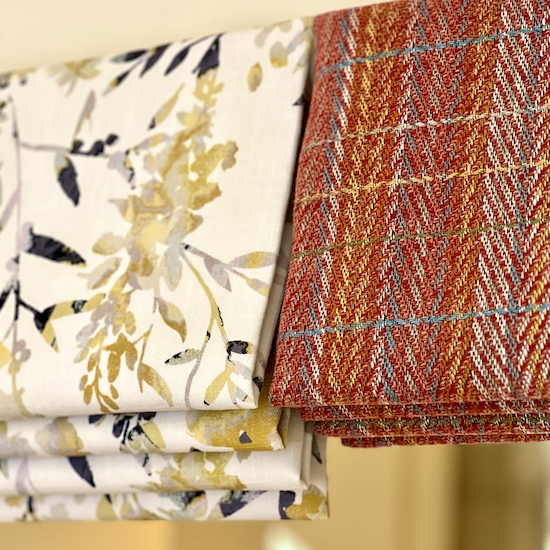
Hand-made Roman Blinds
All Roman Blinds are made to measure to fit your window exactly. The blind is made with your chosen face fabric on the front and a lining on the back which can either be blackout lining or standard lining. The lining has rod pockets stitched at intervals on the back which contain fibreglass rods. The cords run through rings on the rod pockets and as the blind is lifted this creates the folds in the raised blind.
There are two ways to attach the rod pockets through to the face fabric and this is the key distinction between a hand-made blind and a machine-made blind.With a machine-made blind the rod pockets are attached by machine and this means there is a line of machine stitching across the front of the blind along the line of each rod pocket.
For a hand-made blind, a hand sewn technique known as stab stitching is used to attach the rod pockets through to the face fabric every ten centimetres or so. The stab stitches are therefore much less visible than a line of machine stitching and this is the premium bespoke technique which really sets a hand-made blind apart. There is also machine stitching at the top to attach the Velcro on a machine-made blind but not on a hand-made blind. As the machine stitching runs along the line of the folds, that helps make the stitching less noticeable, as does any pattern on the fabric. We always demonstrate both types of blind to clients so they can choose which look they prefer.
Interlining
Interlining a Roman Blind makes it more substantial giving it that plush, luxury look and feel, as well as helping insulate the window.
There are two types of interlining for blinds, either bonded interlining or separate interlining.
A separate interlining is a third layer of fleecy fabric that sits between the face fabric and the lining. This is the ultimate bespoke look and only hand-made blinds can be made with a separate interlining. A bonded interlining is a lining fabric and fleecy layer bonded together, so a blind made with bonded interlining is not quite as plush as with separate interlining but there is a price advantage. If the chosen face fabric is already medium weight or greater a bonded interlining may well suffice, if the face fabric is relatively light then a separate interlining may be beneficial.
Bonded interlining can either be blackout or standard. Machine made blinds are only available with standard or blackout lining, not with bonded interlining.
Choosing fabric
This is the fun part! It’s also where professional help can be extremely helpful. There are literally thousands of fabrics to choose from and many of our clients find that overwhelming. Jo has very wide knowledge of all the ranges and can put together selections of samples for you to make choosing enjoyable and save you lots of time.
We first visit your home so Jo can see your décor and furnishings, discuss your plans and likes/dislikes, plus talk through some initial ideas. We will then send you a selection of samples for each room or window, all of which match the brief and would look lovely. We find clients much prefer to choose from six or eight ideal samples rather than be swamped by hundreds of possibilities. Our clients usually find a perfect choice from the initial samples we send, but more can always be sent if necessary.
Jo is a qualified textile designer and as you might expect has an extremely talented eye for choosing fabrics. This is a gift, it is innate, nature versus nurture. Ask her to help you and you will not be disappointed!
Trims & Borders
Made to measure Roman Blinds are a perfect opportunity to personalise your new blind with a contrast fabric border perhaps, or one of the huge range of trims from a company such as Samuel & Sons: fringes, borders, tassels, beaded trims, gimp, etc, there is enormous choice to give your new blind a unique look.
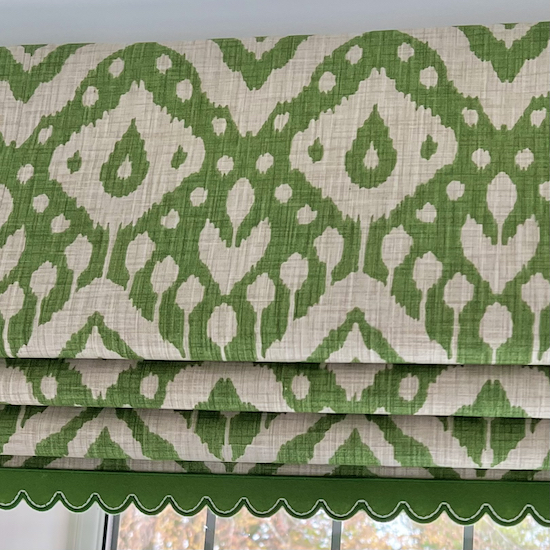
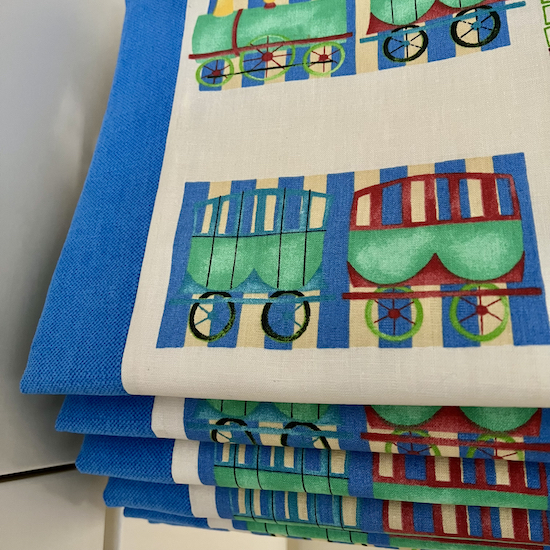
Pattern Placement
Great care is taken when making a blind with a patterned fabric to ensure the pattern is placed as well as possible. We always order an additional repeat to allow for pattern placement. A Roman Blind with the top of the blind running through the middle of the main motif is not a good look! Likewise, the pattern should be centred correctly on the blind and the positioning of stripes at the edges for example needs to be considered. Some patterned fabrics are not really suitable for Roman Blinds, checks can be difficult, anything really with a horizontal line is best avoided.
Voile Roman Blinds
Voile Roman Blinds such as in the photo below can look absolutely stunning! Perhaps with Curtains as well for night-time closing if the windows are overlooked, a Voile Roman Blind is a super stylish window treatment that can work wonderfully with beautiful wooden windows.
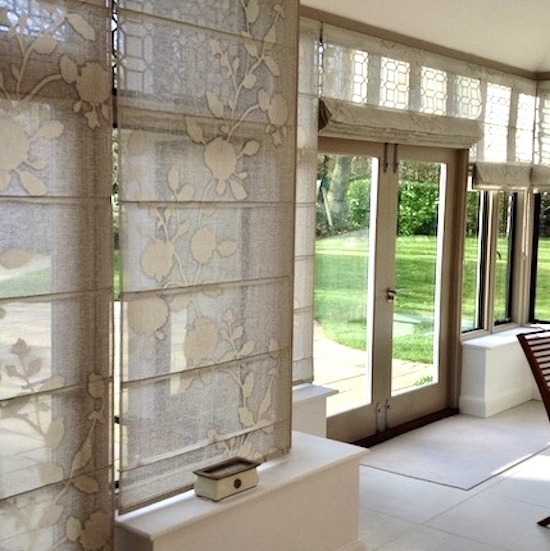
Roman Blind Pelmets
Roman Blind headrails are mostly hidden, only the ends are visible if looking from the side. If the blind is fitted inside the window recess the ends are not visible at all. There are two options for outside the recess if desired, either end caps or a small pelmet. The pelmet is particularly useful for blinds in stairways when the top of the blind is seen from above when coming down the stairs.
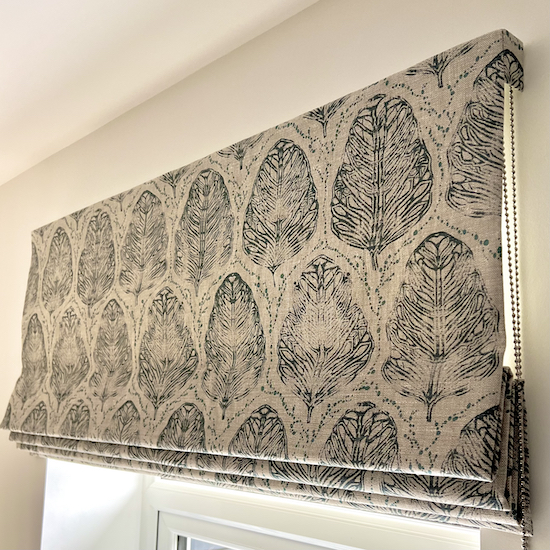
Motorisation
Somfy motorisation is an excellent option. One control can operate all the blinds in a room, or they can be set up individually or in groups. They are a great time saver if you have a number of blinds all round a conservatory for example, or very handy if there is a difficult to reach blind on a staircase perhaps, or for wheelchair users. The battery packs fit neatly out of sight behind the blind just below the headrail and have a plug-in charger, or use normal batteries. With typical twice per day use the battery pack should last around nine months between charges. Roman Blinds can also be hard wired though this requires power being taken to a fuse spur at the top of the window.
Child Safety
All our Roman Blinds comply with the child safety regulations BS EN 13120:2009+A1:2014
Origins
We are asked from time to time why they are called Roman Blinds. For as long as there have been windows there have been coverings. The Egyptians made window coverings with reeds and bamboo was used in ancient China. The Romans started using strips of cloth, which were often soaked in water when it was very hot or dusty. These cloth coverings became more elaborate and cords started to be used to hold the blind up when it wasn’t needed. Evolution led to the blinds we have today and the Roman origins gave us the appropriately named Roman Blinds that are now as popular as ever.
See our Roman Blind Prices here






